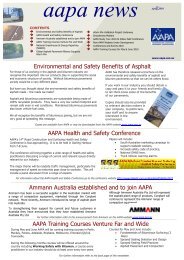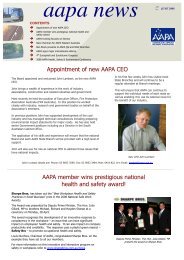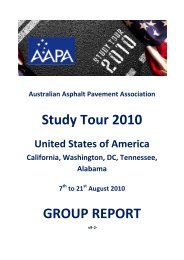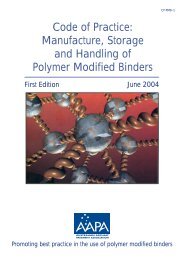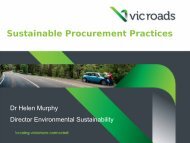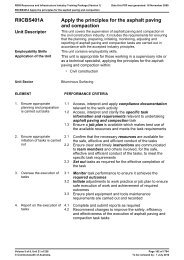Download - Australian Asphalt Pavement Association
Download - Australian Asphalt Pavement Association
Download - Australian Asphalt Pavement Association
- No tags were found...
Create successful ePaper yourself
Turn your PDF publications into a flip-book with our unique Google optimized e-Paper software.
December 20121. AIM OF THIS GUIDEThis guide provides advice on avoiding pollution byminimizing the risk of environmental damage arisingfrom wash-off of bituminous materials from roadconstruction works during wet weather.2. ABOUT THIS GUIDEThis guide has been developed in partnership withthe Environment Protection Authority EPA Victoria. Itprovides advice on avoiding pollution by minimizingthe risk of environmental damage arising from thewash-off of bituminous materials from roadconstruction works during wet weather.This publication is designed to complement ourHS&E “Mission Statement”, which is to contribute tothe provision of a safe and healthy environment forindustry employees and the community, withinresponsible environmental parameters.Although developed in Victoria, in the absence ofsuch documents in other States it is equallyapplicable in other jurisdictions.The document refers to the Austroads “Guide to theSelection of Surfacings”. This document has beenincorporated into Austroads “Guide to <strong>Pavement</strong>Technology Part 3: <strong>Pavement</strong> Surfacings.3. RESPONSIBILITYThe effectiveness of this guide will be depends onthe judgment of the person using it. While it shouldhelp operators to reduce the environmental risksassociated with priming in road construction, it willnot exempt any of the parties from liability shouldprimer or primerbinder wash-off occur causingpollution.4. REFERENCESEPA Victoria Guide for EnvironmentalManagement Spraying Bituminous MaterialsPublication 880 November 2002Austroads “Guide to <strong>Pavement</strong> TechnologyPart 3: <strong>Pavement</strong> Surfacings incorporatingAustroads “Guide to the Selection ofSurfacings”.Austroads/AAPA Work Tip No.18 “SprayedSeal Selection of Initial Treatments5. ACKNOWLEDGEMENTSWe want to thank the following organizations and theirstaff who have contributed to creation and updating thisGuide.EPA StaffAAPA Staff and Members6. AAPA – EPA GUIDEClick on link to access EPA Victoria Guide forEnvironmental Management Spraying BituminousMaterials Publication 880.http://www.epa.vic.gov.au/ourwork/publications/publication/2002/november/880Other guides in this series:- Introduction to health and safety in theflexible pavement industry- Guide 1: Guide to good practice inasphalt and bitumen laboratories- Guide 5: Guide to the safe use of SBS- Guide 6: Safe Working in Heat- Guide 7: Safe Use of Bitumen HosesDisclaimerAlthough the information contained in this booklet is believed to be fundamentally correct and current at time of printing, the <strong>Australian</strong> <strong>Asphalt</strong><strong>Pavement</strong> <strong>Association</strong> does not accept any contractual, tortious or other form of liability for its content or any consequences arising from it use.GUIDE No.8 ENVIRONMENTAL MANAGEMENT WHEN SPRAYING BITUMINOUS MATERIALS
G U I D E L I N E F O R E N V I R O N M E N T A L M A N A G E M E N TS P R AY I N G B I T U M I N O U S M AT E R I A L SPublication 880November 2002Developed in partnership with the <strong>Australian</strong> <strong>Asphalt</strong> <strong>Pavement</strong> <strong>Association</strong>1. I N T R O D U C T I O NPrimers and primerbinders are used in roadconstruction to prevent surface water seepingthrough to the permeable pavement materials andthe underlying natural soils. They also provide abond between the granular materials that form theroad base and the surfacing which may be eitherasphalt or sprayed seal. When applied to a roadsurface they are in liquid form but ‘set-up’ 1 soonafter, remaining soft for some time, beforebecoming fully cured. During this curing 2 stage,there is a risk of the primers and primerbindersbeing washed off the pavement into adjacentdrains and open watercourses causing pollutionand harming aquatic flora and fauna in theseecosystems.Washoff is not only harmful to the environment, itcan delay the completion of a project. Repairingthe road surface, respraying the bitumen andcleaning up polluted waterways will increase costsnot only for the contractor but also the client. Addto these the labour needed to carry out thesetasks and the possible damage to a company’s or1 ‘Set-up’ is a term used to describe an initial stiffening of theprime or primerbinder after spraying. In the case of cutbackbinders it occurs as the binder cools from the sprayingtemperature while for emulsions it occurs as a result of theinitial separation of the emulsion into its component phases ofwater and bitumen.2 ‘Curing’ is the term used to describe the process of thebinder achieving its full strength. For cutbacks it involves theevaporation of volatile solvents (cutter) from the binder whilefor emulsions it involves the complete separation of the waterand bitumen.client’s reputation and it is easy to see whypreventing this type of wash-off not only protectsthe environment but makes good business sense.Parties found to be liable of pollution may faceprosecution and penalties of up to $240,000. Inaddition directors and managers of companiesmay be personally liable and also subject toprosecution. While contractors causing pollutionor an environmental hazard face enforcementaction it is important to note that parties hiring acontractor may also be liable. When engaging acontractor to conduct bitumen spraying, you mustensure that the contractor has the necessary skillsand experience, and systems and precautions inplace, to prevent wash-off of primer or primerbinder. If you direct a contractor to conductspraying operations at a time or in a manner thatcauses pollution of waters or an environmentalhazard you may be guilty of an offence under theEnvironment Protection Act 1970.2. P U R P O S EThis guideline provides advice on avoidingpollution by minimising the risk of environmentaldamage arising from the wash-off of bituminousmaterials from road construction works during wetweather. The guideline does not address otherenvironmental impacts from road constructionsites. The effectiveness of this guideline willdepend on the judgement of the person using it.EPA Victoria 2
G U I D E L I N E F O R E N V I R O N M E N T A L M A N A G E M E N TS P R A Y I N G B I T U M I N O U S M A T E R I A L SWhile this should help operators to reduce theenvironmental risks associated with priming inroad construction, it will not exempt any of theparties from liability should primer or primerbinderwash-off occur causing pollution.3. B A C K G R O U N DCutbacks are a mixture of bitumen and a cutter oil(that is, a volatile hydrocarbon) such as kerosene.The amount of cutter used depends on theporosity of the surface of the granular pavementand the weather conditions at the time ofspraying. Primers contain higher levels of cutterthan primerbinders because they have to achievegreater penetration into the granular material.Primerbinders have a moderate level of cutter toprovide some penetration and to retain the appliedaggregate. The <strong>Australian</strong> Standard AS2157provides further information on the appropriateclassifications for cutback primers andprimerbinders.Bitumen emulsion is a mixture of bitumen andwater, treated with an emulsifying agent and otherstabilising agents. The bitumen is broken into veryfine droplets that are suspended in water. Thesedroplets usually have a positive (cationicemulsions)or negative (anionic emulsions) charge dependingon the emulsifying agent used. Further informationon bitumen emulsion is available in <strong>Australian</strong>Standard AS1160.Primerbinders are generally cationic emulsionsbecause the bitumen droplets are attracted to thesurface of the sealing aggregate, which often hasa negative surface charge. Primers on the otherhand tend to be emulsions with no electricalcharge (non-ionic inverted emulsions).All primers and primerbinders are applied to thepavement surface as liquids using purpose-builtcalibrated sprayers typically at the temperaturesshown in Table 1.Primers and primerbinders may not be totallycured for up to 72 hours (and in rare cases evenlonger). The curing time depends on a number offactors including: Type of binder used (emulsion or cutback); Season (winter, summer); Prevailing weather conditions (dry or wet); Temperature (hot or cold); Type of surface applied to (how porous thegranular material is); and Dampness of the base material.Table 1: Typical spraying temperatures for primers and primerbindersBituminous material Primer PrimerbinderCutback BitumenEmulsion BitumenAt or close toambient100C – 130C70C – 80CEPA Victoria 3
G U I D E L I N E F O R E N V I R O N M E N T A L M A N A G E M E N TS P R A Y I N G B I T U M I N O U S M A T E R I A L SFor cutback bitumens, the curing period dependson how fast the binder cools, how much solvent isin the binder and the rate of evaporation. Thismay range from a few hours on a porous surfacein bright sunny weather to a few days on a tightrelatively impenetrable surface in dull, overcastand cool weather.For emulsions, the curing time depends on therate at which water evaporates from thesuspension and, for primer binders, the strengthof the electrical attractive forces between thebitumen and the aggregate particles. The periodfor this curing process is similar to cutbackbitumens in hot sunny conditions, but is muchshorter in cool and overcast conditions.4. S E L E C T I O N O F P R I M E R O RP R I M E R B I N D E RThe selection of an appropriateprimer/primerbinder is a balance between thetechnical requirements of the work and theenvironmental risks associated with differentbinders in the prevailing weather conditions. TheAustroads ‘Guide to the Selection of Surfacings’and the Austroads/AAPA Work Tip No.18‘Sprayed Seal Selection of Initial Treatments’provide general information on the selection ofprimers and primerbinders.The risk of primer or primerbinder wash-off shouldbe assessed before application as part of thedevelopment of a risk management plan. Thehigher the risk and the more immediate theconsequences, the more comprehensive the riskmanagement plan should be. A risk managementplan should consider how likely wash-off is tooccur and how severe the impact may be on theenvironment and the construction of the road. Forexample, using a cutback primerbinder may be alow risk option if used in conditions when rain isnot anticipated for 24 hours. However, if aconsequence of rain was to be a surface with poorskid resistance as a result of aggregate stripping,and hence a threat to the safety of road users,then it would be prudent to adopt a higher riskcategory. Equally where the construction site is inclose proximity to a watercourse where there islittle or no opportunity for the contractor tointervene to prevent any wash-off entering thewatercourse, a higher risk category should beadopted.Risks of wash-off increases in cooler damperweather because the primer or primerbinderremains in a partly cured state for longer and isexposed to wash-off if it rains during that time.The exposure period is slightly reduced by usingan emulsion.For primerseals, the risk of wash-off is alsogreater on roads carrying heavier traffic becausethe action of the traffic causes the aggregate tostrip and the bitumen to emulsify, making it easierto flow off the pavement.The environmental risks associated with primersor primerbinders are detailed in Table 2. The riskof a wash off associated with priming is typicallygreater than for primersealing due to the presenceof the aggregate in the primerseal. The timing ofspray operations and/or the selection of bindertype should be aimed at achieving a low riskcategory. Table 2 should be used before sprayingto ensure that appropriate measures are in placeto prevent any washoff should rain occur.EPA Victoria 4
G U I D E L I N E F O R E N V I R O N M E N T A L M A N A G E M E N TS P R A Y I N G B I T U M I N O U S M A T E R I A L SCutback bitumenTable 2: Priming/primersealing risk assessmentRisk (1) of wash-off in the event of rain within the stipulated periods aftersprayingWeather 0 – 12 hours 12 – 24 hours 24 – 48 hours Over 48 hoursconditions (2)Fine, sunny,warm/hot,Fine, overcast,cool/warmModerate Moderate Low LowHigh Moderate Low LowDamp, High High Moderate Moderateovercast, warmDamp,overcast, coolWet, overcast,warmWet, overcast,coolUnacceptable High High ModerateUnacceptable Unacceptable High HighUnacceptable Unacceptable Unacceptable UnacceptableBitumen emulsionsRisk (1) of wash-off in the event of rain within the stipulatedperiods after sprayingWeather 0 – 12 hours 12 – 24 hours 24 – 48 hours Over 48 hoursconditions (2)Fine, sunny,warm/hot,Moderate Low Low LowFine, overcast,cool/warmModerate Low Low LowDamp, High Moderate Low Lowovercast, warmDamp,overcast, coolWet, overcast,warmWet, overcast,coolHigh Moderate Moderate ModerateUnacceptable High High ModerateUnacceptable Unacceptable Unacceptable High(1) The risk levels reflect the likelihood of a wash-off from granular pavements on moderate grades with typicalcrossfalls. For roads on steep grades or with abnormal crossfalls or with a low porosity base course, the risk ofwash-off is higher than those shown.(2) Typical temperatures associated with different weather conditions are: Hot ≥ 25ºC, Warm 15ºC - 25ºC; Cool ≤15ºCEPA Victoria 5
G U I D E L I N E F O R E N V I R O N M E N T A L M A N A G E M E N TS P R A Y I N G B I T U M I N O U S M A T E R I A L SUnacceptable riskWhere the risk is unacceptable, the likelihood ofwash-off is so high that regardless of the type ofprimer or primerbinder being used, applicationshould be delayed until conditions improve.High riskWhere the risk is high, application should bedelayed or the application and curing supervisedcontinuously until dry. Precautionary measuressuch as blocking stormwater entry points must beput in place to prevent wash-off in the event ofrain. The weather should be checked regularlyand inspections should be frequent enough toensure that wash-off does not occur. Spillresponse equipment should be in place as aprecautionary measure.Moderate riskWhere there is a moderate risk of wash-offoccurring, inspections should be frequent enoughto ensure that they are able to cater for rainevents. Precautionary measures such as blockingstormwater entry points should be put in place toreduce the risk of wash-off. Spill responseequipment should also be available on site.Low riskWhere there is a low risk of wash-offinspections may be less frequent than theabove categories however the weathershould be monitored to ensure that rainevents can be planned for and preventionmeasures taken accordingly. The locationof storm water entry points and watercourses should be identified and noted sothey can be blocked quickly where workresults in wash-off or weather conditionschange suddenly. Spill responseequipment should also be available.Despite the best forecast, it is possible forweather conditions to change unexpectedly inwhich case the contractor should have a processfor ensuring that all sprayed work completed inthe preceding 24 hours is checked for evidence ofdamage and wash-off and action taken asnecessary. In the event of rain, inspectionfrequency should be increased as a precautionarymeasure.5. W O R K P R A C T I C E SIt is important when spraying bituminous materialto ensure that the work practices are consistentwith minimising the risk of the material enteringthe drainage system and causing anenvironmental hazard or pollution. This shouldinclude: Ensuring that the surface to be sprayed isadequately compacted and swept and at theappropriate moisture content prior to spraying.For cutback primers, the surface should be drybut for cutback primerbinders and emulsionsthe surface should be damp. The retention ofwindrows of material swept from the pavementalong the edges of the pavement can assist inminimising wash-off. Positioning of the sprayer to avoid sprayingbeyond the area to be primed or primersealed,where the bituminous material could be morereadily washed into drainage systems.EPA Victoria 6
G U I D E L I N E F O R E N V I R O N M E N T A L M A N A G E M E N TS P R A Y I N G B I T U M I N O U S M A T E R I A L S Ensuring that the sprayer is well-maintained,operated by a trained crew and that spraynozzles are operating correctly so that thebituminous material is applied at the designrate of application uniformly across thesurface (two light applications may provide alower risk than a single heavy application). Avoiding windy conditions when there is thepotential for spray drift into areas adjacent tothe pavement. Establishing appropriate traffic controlmeasures in the event of damage due to wetweather – for primerseals reducing the speedand intensity of traffic can reduce the severityof wash-off. Clean all equipment in areas that will notimpact on the environment or result in washoffinto the stormwater or open waterways. Site supervisers, senior staff and foreman onsite should be trained in areas such asinspection procedures, spill prevention andresponse, correct handling, storage andcleaning procedures, management of wastematerials and environmental impacts of primeror primerbinder wash off. Site supervisers andsenior staff must ensure all staff follow properprocedures to prevent primer and primerbinder wash-off and all staff should be awareof the environmental impacts that may occur.In road construction work all drains represent anenvironmental risk. While good practice shouldminimise the risk of a wash-off, otherprecautionary measures such as the protection ofdrainage inlet pits or open watercourses shouldbe put in place. Suitable devices for this purposeare sediment and litter traps described in EPApublication 275, ‘Construction techniques forsediment pollution control’. These are alsodescribed in EPA publication 480, ‘Environmentalguidelines for major construction sites’, andshould be implemented if there is any doubt as tothe possible risk of wash-off.6. I N C I D E N T R E S P O N S EDespite the level of risk associated with a possibleprimer/primerbinder wash-off, a risk managementplan should contain emergency responseprocedures. A typical response procedure isshown in the accompanying flowchart (see Figure1). Contact numbers for assistance should becurrent and available so the appropriate help maybe sought in the event of a spill. Spill kits shouldbe easily accessible and fully equipped with acontainer and stock of material which would allowany primer or primerbinder that is washed off tobe safely and effectively cleaned up.The waste material recovered should be placed ina container that will not leak or allow the materialto escape. This waste is classified as prescribedwaste and must be transported by EPA permittedvehicle to a facility with the appropriate EPAlicence for recycling or disposal.7. R E S O U R C E SFor further information and advice contact:<strong>Australian</strong> <strong>Asphalt</strong> <strong>Pavement</strong> <strong>Association</strong>03 9853 3595EPA Victoria1300 EPA VIC (372 842)EPA Victoria 7
G U I D E L I N E F O R E N V I R O N M E N T A L M A N A G E M E N TS P R A Y I N G B I T U M I N O U S M A T E R I A L SFigure 1. Incident response plan1. If the pavement is undertraffic, establish appropriatetraffic control measures2. Isolate the primed or primersealed areato contain the wash-off as much as possibleYes3. Is the wash-off animmediate risk to thecommunity or has it entereda waterway?NoNotes:Where the wash-off has entered astormwater drain and the exitpoint is not immediately apparent,contact the local council or waterauthority for information andassistance4. Contact the following to assist withimmediate control: EPA Pollution Line: 1300 372 842 Fire Brigade: 000 or 9662 2311(emergency only) Police: 0005. Is responsiblesenior managercontactable?No7. Contact EPA if not alreadycontacted. Immediate dispatch ofemergency spill trailer if not already onsiteYes6. Inform manager of incident details Location Time of occurrence Product type and quantity Weather conditions Local environmental conditions8. Order trucks of sand as necessaryfor containment. Where the wash offhas entered a drain or watercourseplace a boom and other absorbentmaterial to contain the wash-off at thenearest available point (ie the outfall ofthe drain or the downstream extent ofthe wash-off)9. Raise incident report10. Replenish contents ofemergency spill trailerManager to make the following arrangementsconsistent with company’s operationalprocedures:immediate dispatch of emergency spilltrailercontact EPAcontact Workcover if spill 200 litrescontact more senior managementcontact Dept of Human Services if thewash-off could impact on public healthContact local council and relevantwater authorityraise Workcover notification forms



